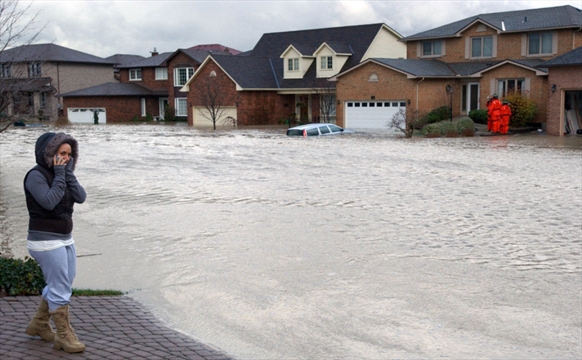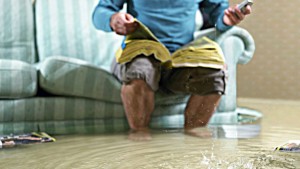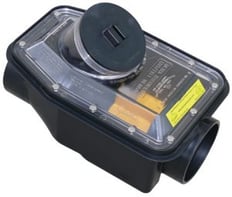Protect your Home from Water & Flood

Water damage can be devastating to your family and home, yet so many homeowners don’t think about preventing water damage until it’s too late. With climate changes bringing more severe weather events to our doorsteps, basement flooding and sewer backups are real risks to your home and possessions. Use these handy tips to take steps now and help reduce the risk of damage to your home.
Seal cracks in foundation walls and basement floors
This is a simple way to help reduce the risk of basement water damage. In most cases, existing cracks can be sealed from the inside of your home without having to dig around your foundation.
Install window wells and covers
Window wells, or wells dug outside a below-grade window, are typically enforced with half-circular or rectangular galvanized steel or polyethylene shields that support the earth and block debris and moisture from reaching your basement windows. Not surprisingly, they can significantly improve drainage and help prevent windowsill rot, too. Besides installing wells, adding a well cover or even plastic sheeting as inexpensive barriers will provide extra protection for such a heavily battered area.
Add a weeping tile or foundation drain

Homes built before the 1950s may not have them, but weeping tile can play an important part in having the proper drainage around your home. A weeping tile (also called a drain tile, perimeter tile, or foundation drain) is a porous pipe used for underground water collection. In case you were wondering, these pipes were originally made from terracotta tiles — hence the name. But in modern days, they are typically corrugated plastic pipes with small slits or weep holes that are buried around your foundation to drain moisture.
Where to direct your weeping tile drainage is an important factor, too. Your safest bet is to install a sump pit and sump pump in your basement and direct weeping tile water to it. From there, it can be pumped a safe distance from your home with a flexible line.
Disconnect your eavestrough downspouts from your weeping tile (or sanitary sewer drain)
Downspouts are intended to move water from your eavestroughs to a more absorbent surface, like your lawn or garden, at least six feet away from your home. Downspouts connected to your weeping tile or sanitary sewer drain can overwhelm these systems with water, which can lead to a sewer backup. If redirecting your downspouts, avoid sending water to your driveway or sidewalk as it can ice over in the winter and create a different kind of hazard.
Disconnect your weeping tile from the sanitary or storm sewer drain (and install a sump pit and sump pump)
Weeping tile connected to the sanitary or storm sewer drain means more water flowing into the municipal sewer system during a heavy rainfall — a perfect storm for sewer backup. Be sure to install a sump pump (in its own sump pit) to move water to the surface where it can safely run off. If you’re unsure of where to direct the flow, contact your municipal government to confirm the right pathway for water runoff.
And while you’re at it…get a backup power source for your sump pump
Sump pumps require electricity and won’t work during power failures. Have your sump pump connected to a reliable backup power source, such as a battery or generator, so it works when you need it most.
Install a backwater valve

Mainline backwater valves allow sewage to flow out of your house — but not back in — when the sanitary sewer system becomes overwhelmed. Backwater valves are required by some municipalities and recommended by others, so if you own a newer home, you likely had one installed during construction. If you’re unsure, most valves have an easily removed cover (somewhere in your basement) to allow for regular maintenance, so start looking! Should you discover your older home is without one, a professional plumber can secure the proper permits and install one recommended by your municipality.
Avoid pouring fats, oils, and grease down your drains
Over time, they build up and create blockages that can lead to a sewer backup. Dispose of these substances with your regular food waste.
Clean your eavestroughs and downspouts, and keep storm sewer grates clear
Cleaning leaves and debris out of your eavestroughs at least once a year can avoid clogging, and keeping storm sewer grates clear of leaves, trash, ice, and snow is also helpful. When storm sewer systems are clogged, there is a higher risk of water flowing back toward your property. If you notice repeated clogging of your street’s sewer grate, contact your municipality.
Design landscaping to allow water to run away from your house
Runoff from a two-storey home after a 25-mm rainfall can fill five bathtubs. Diverting water from your home naturally — with sloping hills and strategically placed shrubbery — can help to keep your basement dry.
At the end of the day, even the most prepared homeowner might not win against Mother Nature in the event of a flood. So remember to keep irreplaceable family heirlooms and important documents high and dry — and out of the basement.